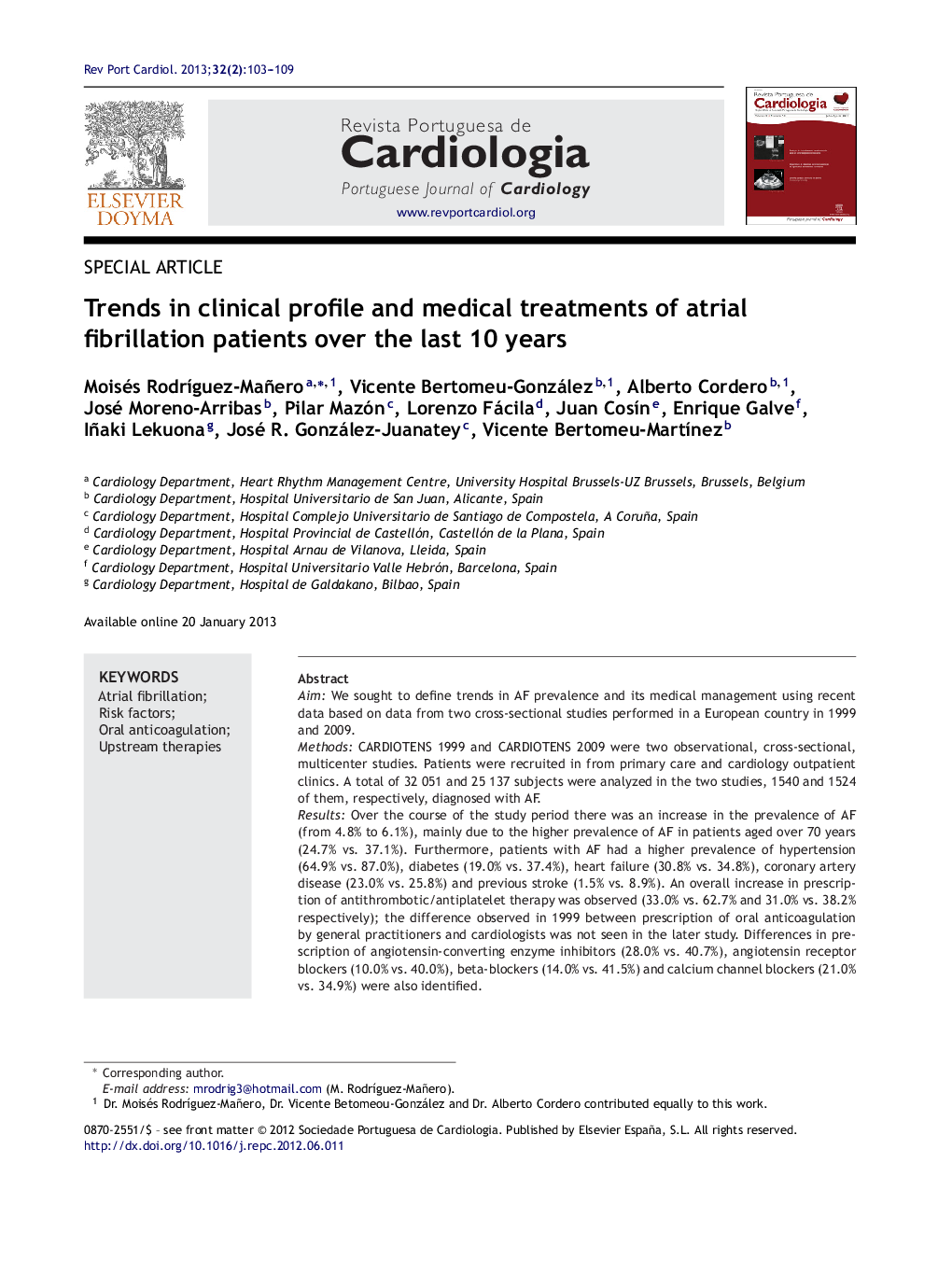| Article ID | Journal | Published Year | Pages | File Type |
|---|---|---|---|---|
| 1126466 | Revista Portuguesa de Cardiologia | 2013 | 7 Pages |
AimWe sought to define trends in AF prevalence and its medical management using recent data based on data from two cross-sectional studies performed in a European country in 1999 and 2009.MethodsCARDIOTENS 1999 and CARDIOTENS 2009 were two observational, cross-sectional, multicenter studies. Patients were recruited in from primary care and cardiology outpatient clinics. A total of 32 051 and 25 137 subjects were analyzed in the two studies, 1540 and 1524 of them, respectively, diagnosed with AF.ResultsOver the course of the study period there was an increase in the prevalence of AF (from 4.8% to 6.1%), mainly due to the higher prevalence of AF in patients aged over 70 years (24.7% vs. 37.1%). Furthermore, patients with AF had a higher prevalence of hypertension (64.9% vs. 87.0%), diabetes (19.0% vs. 37.4%), heart failure (30.8% vs. 34.8%), coronary artery disease (23.0% vs. 25.8%) and previous stroke (1.5% vs. 8.9%). An overall increase in prescription of antithrombotic/antiplatelet therapy was observed (33.0% vs. 62.7% and 31.0% vs. 38.2% respectively); the difference observed in 1999 between prescription of oral anticoagulation by general practitioners and cardiologists was not seen in the later study. Differences in prescription of angiotensin-converting enzyme inhibitors (28.0% vs. 40.7%), angiotensin receptor blockers (10.0% vs. 40.0%), beta-blockers (14.0% vs. 41.5%) and calcium channel blockers (21.0% vs. 34.9%) were also identified.ConclusionsThe number of patients with AF and a higher risk for thromboembolic events increased over the last 10 years. More aggressive antithrombotic treatment has been observed, especially in older patients.
ResumoObjetivosProcuramos definir as tendências prevalentes de fibrilhação auricular (FA) e o tratamento médico utilizando dados recentes, colhidos de dois estudos transversais realizados num país europeu entre 1999 e 2009.MétodosCARDIOTENS 1999 e CARDIOTENS 2009 são dois estudos observacionais, transversais multicêntricos. Os pacientes foram recrutados de clínicas de ambulatório dirigidas por generalistas e cardiologistas. Um total de 32 051 e de 25 137 indivíduos foram analizados; 1 540 e 1 524 dos quais foram diagnosticados com FA.ResultadosDurante a realização do nosso estudo houve um aumento na incidência de FA (de 4,8% a 61,%) sobretudo devido à elevada prevalência de FA em pacientes com mais de 70 anos de idade (24,7% versus 37,1%). Para além disso doentes com FA revelam mais tendência para hipertensão (64,9% versus 87,0%), diabetes mellitus (19,0% versus 37,4%), insuficiência cardíaca (30,8% versus 34,8%), doença coronária (23% versus 25,8%) e acidente vascular cerebral prévio (1,5% versus 8,9%). No que se refere a terapia antitrombótica/antiplaquetária, foi observado um aumento generalizado na sua prescrição (33,0% versus 62,7% e 31,0% versus 38,2% respetivamente). Sobre este assunto, a diferença de prescrição de anticoagulantes orais observada em 1999 entre os generalistas e cardiologistas não se verifica atualmente. Diferenças nos agentes inibidores da enzima de conversão da angiotensina (28,0% versus 40,7%), bloqueadores recetores da angiotensina (10,0% versus 40,0%), beta-bloqueantes (14,0% versus 41,5%) e bloqueadores dos canais de cálcio (21,0% versus 34,9%) foram igualmente identificadas.ConclusõesO número de pacientes com FA e eventos trombo-embólicos com risco mais elevado aumentou ao longo da última década. Um tratamento antitrombótico mais agressivo foi observado sobretudo na população mais idosa.
